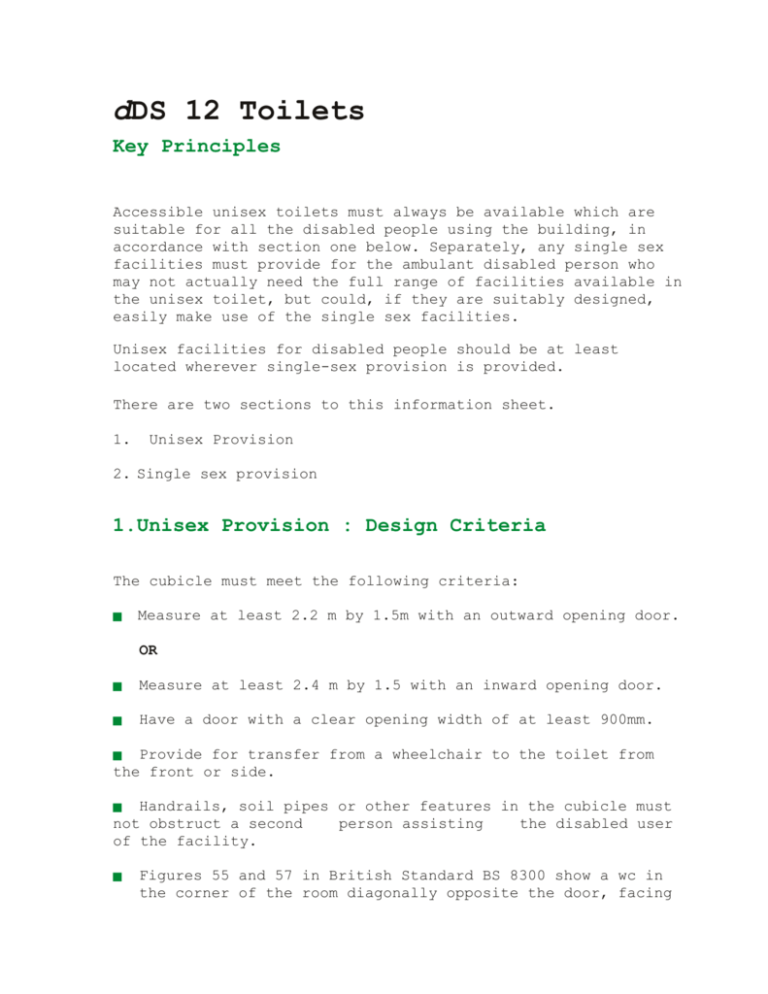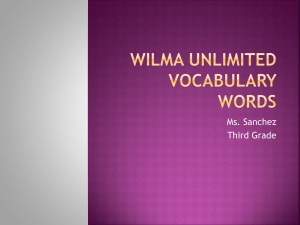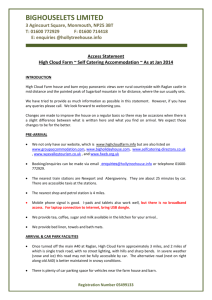dDS12 - Toilets (Word, 36 KB)
advertisement

dDS 12 Toilets Key Principles Accessible unisex toilets must always be available which are suitable for all the disabled people using the building, in accordance with section one below. Separately, any single sex facilities must provide for the ambulant disabled person who may not actually need the full range of facilities available in the unisex toilet, but could, if they are suitably designed, easily make use of the single sex facilities. Unisex facilities for disabled people should be at least located wherever single-sex provision is provided. There are two sections to this information sheet. 1. Unisex Provision 2. Single sex provision 1.Unisex Provision : Design Criteria The cubicle must meet the following criteria: Measure at least 2.2 m by 1.5m with an outward opening door. OR Measure at least 2.4 m by 1.5 with an inward opening door. Have a door with a clear opening width of at least 900mm. Provide for transfer from a wheelchair to the toilet from the front or side. Handrails, soil pipes or other features in the cubicle must not obstruct a second person assisting the disabled user of the facility. Figures 55 and 57 in British Standard BS 8300 show a wc in the corner of the room diagonally opposite the door, facing along the length of the room and located 500mm from the wall by the side of it to the centre line of the wc. The front of the seat should be 750mm from the wall behind the wc. The wc seat should be 480mm above floor level. A hand rinse basin is shown fixed to the wall by the side of the wc with the nearest side 140mm to 160mm forward from the front of the wc seat. The rim of the basin is shown 720mm to 740mm above floor level. A lever operated mixer tap is shown fitted to the side of the basin nearest to the wc. A drop down grab rail is shown next to the wc 820mm from the wall by the side of the wc, 680mm above floor level when it is lowered. A 600mm long horizontal grab rail is shown fixed to the wall by the side of the wc at 680mm above floor level with the nearest end 250mm from the wall behind the wc. A similar closing bar is fitted to the inner face of an outward opening door. Three 600mm long vertical grab rails centred on 1100mm above floor level are shown on the 'off side' of the wc 970mm from the wall by the side of the wc, next to the basin 850mm from the wall behind the wc and on the opposite side of the basin. An emergency alarm pull cord is shown just forward of the wc between the horizontal grab rail and the wall, with bangles at 100mm above floor level and to suit somebody seated on the wc. The alarm reset button and the toilet paper dispenser are shown above the horizontal grab rail. A soap dispenser and a paper towel dispenser are shown above the basin. A hand drier is shown on the far side of the basin from the wc. A sanitary dispenser is shown on the end wall opposite the wc. The top of the sanitary dispenser and bottom of the other fittings is shown between 800mm and 1100mm above floor level. A colostomy shelf is shown in the corner of the room next to the wc at 950mm above floor level. A larger shelf is shown at the far end of the wall by the side of the wc at basin height. A sanitary disposal bin should be provided beneath the colostomy shelf/by the side of the wc. A disposal bin should be provided beneath the larger shelf. Clothes hooks and a full length mirror should be provided opposite the basin. Handrails must contrast with the background colour scheme. All door locks etc should be designed for people with limited dexterity making use of lever style handles. The toilet flush must be on the off-side and located no higher than 1m from the floor. In addition to the alarm specified in BS 8300, (see above) consideration should be given to an alarm that consists of: 1. A cord running around the entire internal perimeter of the cubicle, 2. located 150mm above floor level and; 3. having a contrasting colour to the background walls and floor. The hand dryer must be accessible from the toilet. A unisex cubicle is located as close as possible to the entrance and/or waiting area of the building. See diagrams for full layout details. Alternative peninsular layouts are described in BS 8300, page 118. 2. Single Sex Provision : Design Where the toilet accommodation is accessible to wheelchair users: At least one urinal must be set at a lower height of 380mm (measured to the rim from the floor level). At least one wash hand basin must be located at a height of 700mm Where the toilet accommodation disabled people: is accessible to ambulant At least one urinal must be set at a lower height of 500mm. In general all others wash hand basins must be located at a height of 800mm. In the above cases the rim of any urinal must project at least 360mm from the wall. A single handrail must be provided above any urinal and a 600mm long handrail located on either side of the urinal, with their mid point positioned 1100mm above the floor. in A space at least 900mm wide by 1350mm deep must be provided front of any urinal. A space at least 1500mm by 1500mm should be provide in front of any wash hand basin. At least one cubicle and thereafter one in every five must: Be at least 800mm wide and 1500mm long. Have an outward opening door fitted with a horizontal bar on the inner face to assist closing. Have a clear door width of at least 750mm. Have a toilet pan at least 480mm high (measured to top of seat). Be provided with three horizontal handrails, 680mm high from the floor, located on the rear wall and each of the sides of the cubicles with the front end 200mm forward of the wc. A 600mm long vertical handrail should be located on either side of the cubicle, with their mid point positioned 1100mm above the floor. All door locks etc must have a lever style handles suitable for use by people with limited dexterity. All controls such as light switches etc must be in the height range of 900mm to 1200mm, including hand dryers and operable by someone with limited dexterity. All controls taps and handrails must contrast with the surrounding background, walls or facilities. Facilities conforming to these standards must be clearly signed. Other Issues Access to any toilet facility must be in accordance with dDS 8 & 9. BS 8300 contains detailed guidance on provision for domestic situations. Cross References dDS 2 Checklist dDS 8 Doors dDS 18 Receptions dDS 17 Design Principles dDS 21 Further Information









